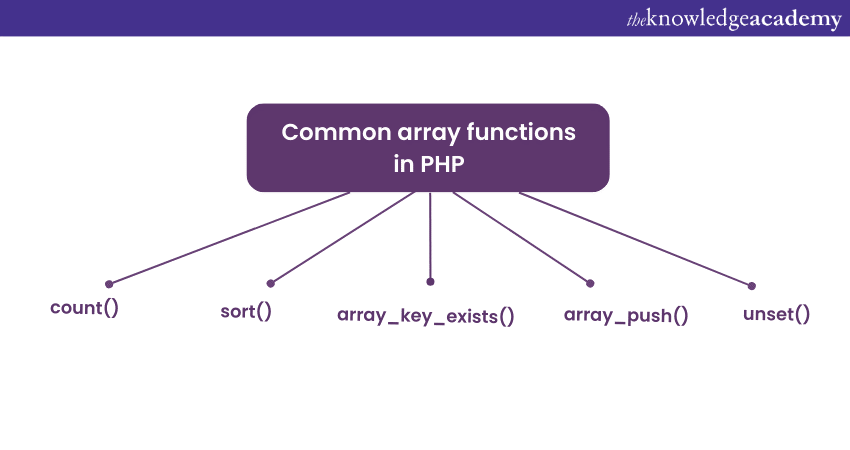We may not have the course you’re looking for. If you enquire or give us a call on +44 1344 203999 and speak to our training experts, we may still be able to help with your training requirements.
We ensure quality, budget-alignment, and timely delivery by our expert instructors.

PHP is known as one of the most popular programming languages for web development across the world. One of the many structures that make PHP so convenient and easy to use is the PHP Array. This blog will tell you all you need to know about a PHP Array, its basic syntax, its types, its importance, its functions and best practices. Read below to find out more!
Table of Contents
1) What is a PHP Array?
a) The basic syntax of PHP Array
b) Types of PHP Arrays
c) Importance of PHP Arrays
2) Common array functions in PHP
3) Best practices for working with PHP Arrays
4) Conclusion
What is a PHP Array?
A PHP Array is a fundamental data structure used in programming to store and organise multiple values under a single variable. It provides a convenient way to manage and manipulate collections of data, making it an essential concept in PHP development.
In simple terms, an array can be thought of as a container that holds various elements. These elements can be of different types, such as numbers, strings, booleans, or even other arrays. By using arrays, you can efficiently manage large amounts of related data within a single variable.
Arrays in PHP are versatile and offer flexibility in representing complex data structures. Regardless of whether you are dealing with a list of names, a collection of user details, or even a multidimensional database result, arrays can handle these scenarios effectively.
Want to master PHP Programming and build dynamic websites? Join our PHP Programming Training Course now!
Basic syntax of PHP Array
Before diving further into PHP Arrays, let's explore the basic syntax used to work with them. In PHP, you can declare an array using the following syntax: “$myArray = array(value1, value2, value3, ...);” Here, $myArray is the variable name assigned to the array, and value1, value2, value3, and so on represent the elements you want to store within the array.
To access specific elements of the array, you use their corresponding index. In PHP, array indexes start from 0, so the first element of an array would have an index of 0, the second element would have an index of 1, and so on. For example: “echo $myArray[0]; //” Outputs the first element of the array. Using the aforementioned code snippet, you can retrieve and display the value of the first element stored in the $myArray variable.
Types of PHP Arrays
PHP Arrays come in different types, each suited for specific use cases. Understanding these array types will help you leverage their unique features and capabilities effectively. Let's explore the three main types of PHP Arrays:
1) Indexed arrays: Indexed arrays, also known as numeric arrays, are the simplest and most commonly used type of array in PHP. In an indexed array, each element is assigned a numeric index starting from 0 and incrementing by 1 for each subsequent element. The index serves as a unique identifier for accessing and manipulating the array elements.
Here's an example of an indexed array: “$fruits = array("Apple", "Banana", "Orange");” In the above code snippet, $fruits is an indexed array that stores the names of three fruits. The elements can be accessed using their corresponding index, such as $fruits[0] for "Apple", $fruits[1] for "Banana", and $fruits[2] for "Orange".
2) Associative arrays: Associative arrays, also referred to as key-value pairs, allow you to assign custom keys to each element in the array. Unlike indexed arrays, which use numeric indexes, associative arrays use strings or integers as keys. This key-value mapping provides a more descriptive and meaningful way to organise and retrieve data from the array, especially when using a PHP Function to efficiently handle the data retrieval process.
Consider the following example:
“$student = array(
"name" => "John Smith",
"age" => 20,
"university" => "ABC University"
);”
In the above code snippet, $student is an associative array that stores information about a student. The keys "name", "age", and "university" are associated with their respective values. You can access the elements of an associative array using their keys, such as $student["name"] for "John Smith", $student["age"] for 20, and $student["university"] for "ABC University".
3) Multidimensional arrays: Multidimensional arrays are arrays within arrays, allowing you to create more complex data structures. With multidimensional arrays, you can store and access data in a hierarchical manner. Each element of a multidimensional array can be an array itself, enabling the creation of nested structures.
Here's an example of a multidimensional array representing a matrix:
“$matrix = array(
array(1, 2, 3),
array(4, 5, 6),
array(7, 8, 9)
);”
In the above code snippet, $matrix is a multidimensional array that represents a 3x3 matrix. Each inner array constitutes a row of the matrix, and the elements within the inner arrays represent the values of each cell. You can access specific elements of a multidimensional array using multiple indexes, such as $matrix[0][0] for 1, $matrix[1][2] for 6, and $matrix[2][1] for 8.
Importance of PHP Arrays
Arrays play a crucial role in programming for several reasons:
1) Organisation and access: Arrays allow you to organise related data elements in a structured manner. You can assign each element a unique index or key, making it easy to retrieve and manipulate specific values within the array.
2) Efficiency: By using arrays, you can optimise the storage and retrieval of data. Instead of creating separate variables for each value, you can store them in an array, reducing code duplication and enhancing efficiency.
3) Data manipulation: Arrays provide a wide range of functions and methods to manipulate the stored data. Whether you need to add or remove elements, sort the array, or perform complex operations, PHP offers an array of built-in functions to simplify these tasks.
4) Iterating and looping: Arrays are particularly useful when you need to iterate over a set of values. Using loops, such as the PHP for Loop, you can access each element of the array sequentially, perform operations on them, and automate repetitive tasks efficiently.
Common array functions in PHP
PHP provides a variety of built-in array functions that enable you to manipulate and operate on arrays efficiently. These functions simplify common tasks and allow you to process data more effectively. Let's explore some of the most commonly used array functions in PHP:

1) count(): The count() function is used to return the number of elements present in an array. It is particularly useful when you need to determine the size or length of an array. For example:
“$numbers = array(1, 2, 3, 4, 5);
$count = count($numbers);”
In the above example, the count() function is used to determine the number of elements in the $numbers array, which is 5.
2) sort(): The sort() function is used to sort an array in ascending order. It rearranges the elements based on their values. For example:
“ $fruits = array("Apple", "Banana", "Orange");
sort($fruits);”
After executing the sort() function, the $fruits array will be sorted alphabetically, resulting in ["Apple", "Banana", "Orange"].
3) array_key_exists(): The array_key_exists() function checks if a specified key or index exists in an array. It returns true if the key is found and false otherwise. For example:
“$student = array(
"name" => "John Smith",
"age" => 20,
"university" => "ABC University"
);
if (array_key_exists("age", $student)) {
echo "Age exists in the student array.";
} else {
echo "Age does not exist in the student array.";
}”
In the above example, the array_key_exists() function is used to check if the key "age" exists in the $student array. Since the key is present, the output will be "Age exists in the student array."
4) array_push(): The array_push() function allows you to add one or more elements to the end of an array. It modifies the original array by appending the new elements. For example:
“$numbers = array(1, 2, 3);
array_push($numbers, 4, 5);”
After executing the array_push() function, the $numbers array will contain the additional elements [1, 2, 3, 4, 5].
5) unset(): The unset() function removes a specific element from an array. It takes the array and the index or key of the element to be removed as parameters. For example:
“$fruits = array("Apple", "Banana", "Orange");
unset($fruits[1]);”
After executing the unset() function, the element at index 1 (in this case, "Banana") will be removed from the $fruits array.
Best practices for working with PHP Arrays
When working with PHP Arrays, follow these best practices:
1) Use descriptive variables and key names.
2) Avoid global and pass arrays as function arguments.
3) Validate array access to avoid errors.
4) Prefer foreach() loops for iteration.
5) Avoid unnecessary functions for performance.
6) Utilise built-in functions for concise code.
7) Document complex structures for clarity.
8) Optimise memory usage for large arrays.
9) Implement proper error handling.
10) Regularly review and refactor code.

Conclusion
All in all, PHP Arrays are powerful tools for managing and organising data in web development. Understanding the different array types, such as indexed, associative, and multidimensional arrays, allows for versatile data storage. When working with web technologies, it's also important to understand difference between PHP vs HTML, as PHP enables dynamic content generation, whereas HTML structures the static elements of a webpage. By following best practices and leveraging common functions, developers can write efficient and maintainable code.
Unlock your coding potential with our Computer Programming Courses. Sign up today and embark on your journey to becoming a skilled programmer!
Upcoming Programming & DevOps Resources Batches & Dates
Date
 PHP Course
PHP Course
Thu 3rd Jul 2025
Thu 4th Sep 2025
Thu 6th Nov 2025
Thu 15th Jan 2026
Thu 5th Mar 2026
Thu 2nd Jul 2026
Thu 22nd Oct 2026






 Top Rated Course
Top Rated Course


 If you wish to make any changes to your course, please
If you wish to make any changes to your course, please


